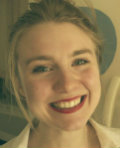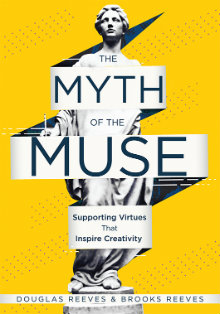Supporting Virtues That Inspire Student Creativity
The Myth of the Muse: Supporting Virtues that Inspire Creativity
By Douglas Reeves and Brooks Reeves
(Solution Tree, 2017 – Learn more)

In 2017 schools ask students to exercise creativity every day. These students need to know what a creative mindset means, and how creativity can be used to solve the world’s problem.
Father and son author team Douglas and Brooks Reeves attempt to take an evidence-based approach to bridging the gap mentioned early on in the book: “The value placed on creativity is well documented, but the reality is that the deck is stacked against the creative process”(2).

The Myth of the Muse clearly targets an audience of K-12 educators and includes numerous suggestions for incorporating their tenets into the instruction of ELA, math, science, social studies, and more. Reeves (the noted education researcher) and Reeves (the award-winning stage actor) provide many a feature that I know teachers respond well to, including reflection questions at the end of each chapter and even a personality test on one’s own beliefs in the realm of creativity, offered early in the book.
In addition to these features the authors state that they intentionally included extra wide margins and encourage vigorous note taking. Specifically, as this suggestion appears in the chapter on the importance of curiosity while engaging in creative experimentation and evaluation, they suggest you use their ample margins to ask questions of the text, critical or otherwise.
Excellent resources and references
The book contains well documented sources in the bibliography and in text citations, making it incredibly easy for educators and readers of all kinds to immediately absorb the resources that made the Myth of the Muse possible. There are two appendices, the latter with suggestions for using these findings on creativity as a leader (perhaps mostly denoting teachers), and the former containing a how-to guide for the assessment of creative work.
My favorite part of the section contains a rubric for rubric-creation for creativity (109). A rubric for making a rubric? My future middle school teacher self definitely rolls her eyes at this, but my present day pre-service teacher self finds it one of the best parts of the whole book!
Although these and many other aspects of this book appear most useful to teachers, I also felt a very wonderful growth happening within myself as an artist as I took in the many new insights and challenges the book presents. I chose this book to read as an artist and as an aspiring educator and found it useful for both of these roles.
In fact, The Myth of the Muse helped me to realize that my life as a teacher will always be directly informed by my own artistic practices, both as a demonstrator for my students and as a creator of opportunities for learning and growth.
Modeling the practices
Reeves and Reeves advocate that teachers model the creative practices the authors identify as particularly successful, based on cognitive research. The authors “understand creativity to be the process of experimentation, evaluation, and follow-through.” While discussing the first element of experimentation, they include a chapter on curiosity. The majority of this chapter explains an issue of social inequality: “Although educators sincerely wish to encourage creativity and curiosity, these are often discouraged among half of the human race – females (Sak & Maker, 2006)”(26).
Without ever using the terms “sexism” or “feminism” or anything suggesting a broader scope, the book merely cites examples and studies of women in the workplace and girls at school. They paint a picture of women too timid to speak up in meetings, girls too focused on being thought of as the good girl in class, causing females old and young to exercise too much restraint in the criticism of the creative work of their peers.
I agree that this (quieter, more likely to be interrupted, “good girl”) mindset unfairly interrupts the creative process for too many girls, and in turn, whole groups (see Chapter 6 on Collaboration). I found the piece lacking further analysis of the root cause of this problem. There is an anecdote discussing the role teachers must play in helping quieter students understand that success includes a balance of obedient listening and vocal critical challenging.
Some universal truths
It would be hard to read a book on as universal a subject as the entire practice of creativity and not find many questionable entries. Nevertheless, these authors uncovered some universal truths, and the tips for application of these truths in the K-12 classroom make this book worthwhile and satisfying. According to my individual creative self, these truths feel the most universal:
✻ “Part of the paralysis that accompanies writer’s block is the notion that the words, phrases, and story have to be right on the very first try….by getting into the habit of repeating work already done, we take the pressure off of trying to get it right the first time”(41).
✻ “When we teach students about creativity, therefore, we must do more than simply admonish them to be different. First, they must be clear about work they admire and what they find inspiring, and then they lay a clear foundation for their creative contributions to the world. Attribution is the beginning of creative synthesis”(57)
✻ “It is not merely practice, but deliberate practice…that produces expert results….it is marked by repetition and perfection. The amateur may repeat a section of music until the notes are correct; the professional will continue the process until the most difficult passages can be played with automaticity”(61).
✻ “Ensure you have some time, even a small amount, to yourself each day without interruptions from the outside world”(64).
I encourage other readers to underline those which feel most universal to them and incorporate them into daily practice.
Sophie Cameron is finishing her studies in education, theater, and poetry at College of the Atlantic in Bar Harbor Maine. She is a founding producer of Welcome HomeSick Productions based in Washington D.C., and a longtime Summerstock Playwright/Producer/Director (for ages 7-17) at Lumina Studio Theatre based in Silver Spring Maryland. Sophie has enjoyed cultural and performance based art and literacy education with every age group she’s spent time with.





























